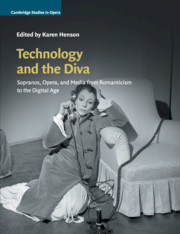Book contents
- Technology and the Diva
- Cambridge Studies in Opera
- Technology and the Diva
- Copyright page
- Dedication
- Contents
- Illustrations
- Musical Examples
- Contributors
- Book part
- A Chronology
- Introduction: Of Modern Operatic Mythologies and Technologies
- 1 Mythologies of the Diva in Nineteenth-Century French Theater
- 2 Coloratura and Technology in the Mid Nineteenth-Century Mad Scene
- 3 Photographic Diva: Massenet's Relationship with the Soprano Sibyl Sanderson
- 4 “Pretending to Be Wicked”: Divas, Technology, and the Consumption of Bizet's Carmen
- 5 The Silent Diva: Farrar's Carmen
- 6 The Domestic Diva: Toward an Operatic History of the Telephone
- 7 The Absent Diva: Notes Toward a Life of Cathy Berberian
- 8 The Televisual Apotheosis of the Diva in István Szabó's Meeting Venus
- 9 Diva Poses by Anna Netrebko: On the Perception of the Extraordinary in the Twenty-First Century
- Afterword: Opera, Media, Technicity
- Notes
- Bibliography
- Index
- References
6 - The Domestic Diva: Toward an Operatic History of the Telephone
Published online by Cambridge University Press: 05 September 2016
- Technology and the Diva
- Cambridge Studies in Opera
- Technology and the Diva
- Copyright page
- Dedication
- Contents
- Illustrations
- Musical Examples
- Contributors
- Book part
- A Chronology
- Introduction: Of Modern Operatic Mythologies and Technologies
- 1 Mythologies of the Diva in Nineteenth-Century French Theater
- 2 Coloratura and Technology in the Mid Nineteenth-Century Mad Scene
- 3 Photographic Diva: Massenet's Relationship with the Soprano Sibyl Sanderson
- 4 “Pretending to Be Wicked”: Divas, Technology, and the Consumption of Bizet's Carmen
- 5 The Silent Diva: Farrar's Carmen
- 6 The Domestic Diva: Toward an Operatic History of the Telephone
- 7 The Absent Diva: Notes Toward a Life of Cathy Berberian
- 8 The Televisual Apotheosis of the Diva in István Szabó's Meeting Venus
- 9 Diva Poses by Anna Netrebko: On the Perception of the Extraordinary in the Twenty-First Century
- Afterword: Opera, Media, Technicity
- Notes
- Bibliography
- Index
- References
- Type
- Chapter
- Information
- Technology and the DivaSopranos, Opera, and Media from Romanticism to the Digital Age, pp. 104 - 123Publisher: Cambridge University PressPrint publication year: 2016
References
Bibliographical Sources
- 1
- Cited by



